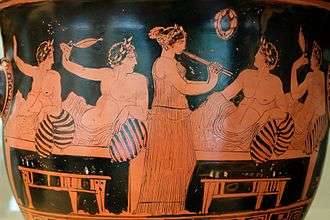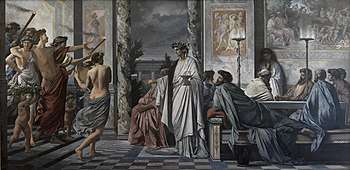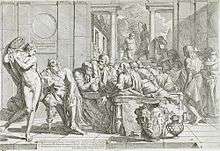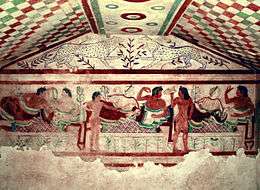Symposium
In ancient Greece, the symposium (Greek: συμπόσιον symposion or symposio, from συμπίνειν sympinein, "to drink together") was a part of a banquet that took place after the meal, when drinking for pleasure was accompanied by music, dancing, recitals, or conversation.[1] Literary works that describe or take place at a symposium include two Socratic dialogues, Plato's Symposium and Xenophon's Symposium, as well as a number of Greek poems such as the elegies of Theognis of Megara. Symposia are depicted in Greek and Etruscan art that shows similar scenes.[1]

In modern usage, it has come to mean an academic conference or meeting such as a scientific conference. The equivalent of a Greek symposium in Roman society is the Latin convivium.[1]
Setting and social occasion

The Greek symposium was a key Hellenic social institution. It was a forum for men of respected families to debate, plot, boast, or simply to revel with others. They were frequently held to celebrate the introduction of young men into aristocratic society. Symposia were also held by aristocrats to celebrate other special occasions, such as victories in athletic and poetic contests. They were a source of pride for them.
Symposia were usually held in the andrōn (ἀνδρών), the men's quarters of the household. The participants, or "symposiasts", would recline on pillowed couches arrayed against the three walls of the room away from the door. Due to space limitations, the couches would number between seven and nine, limiting the total number of participants to somewhere between fourteen and twenty seven[2] (Oswyn Murray gives a figure of between seven and fifteen couches and reckons fourteen to thirty participants a "standard size for a drinking group").[3] If any young men took part, they did not recline but sat up.[4] However, in Macedonian symposia, the focus was not only on drinking but hunting, and young men were allowed to recline only after they had killed their first wild boar.

Food and wine were served. Entertainment was provided, and depending on the occasion could include games, songs, flute-girls or boys, slaves performing various acts, and hired entertainment.
Symposia often were held for specific occasions. The most famous symposium of all, described in Plato's dialogue of that name (and rather differently in Xenophon's) was hosted by the poet Agathon on the occasion of his first victory at the theater contest of the 416 BC Dionysia. According to Plato's account, the celebration was upstaged by the unexpected entrance of the toast of the town, the young Alcibiades, dropping in drunken and nearly naked, having just left another symposium.
The men at the symposium would discuss a multitude of topics—often philosophical, such as love and the differences between genders.
Drinking

A symposium would be overseen by a "symposiarch" who would decide how strong the wine for the evening would be, depending on whether serious discussions or sensual indulgence were in the offing. The Greeks and Romans customarily served their wine mixed with water, as the drinking of pure wine was considered a habit of uncivilized peoples. However, there were major differences between the Roman and Greek symposia. A Roman symposium (convivium) served wine before, with and after food, and women were allowed to join. In a Greek symposium, wine was only drunk after dinner, and women were not allowed to attend.[5] The wine was drawn from a krater, a large jar designed to be carried by two men, and served from pitchers (oenochoe). Determined by the Master of Ceremonies, the wine was diluted to a specific strength and was then mixed. Slave boys would manage the krater, and transfer the wine into pitchers. They then attended to each man in the symposium with the pitchers and filled their cups with wine.[6] Certain formalities were observed, most important among which were libations, the pouring of a small amount of wine in honour of various deities or the mourned dead. In a fragment from his c. 375 BC play Semele or Dionysus, Eubulus has the god of wine Dionysos describe proper and improper drinking:
For sensible men I prepare only three kraters: one for health (which they drink first), the second for love and pleasure, and the third for sleep. After the third one is drained, wise men go home. The fourth krater is not mine any more – it belongs to bad behaviour; the fifth is for shouting; the sixth is for rudeness and insults; the seventh is for fights; the eighth is for breaking the furniture; the ninth is for depression; the tenth is for madness and unconsciousness.
In keeping with the Greek virtue of moderation, the symposiarch should have prevented festivities from getting out of hand, but Greek literature and art often indicate that the third-krater limit was not observed.[7]
Pottery
Symposiums are often featured on Attic pottery and Richard Neer has argued that the chief function of Attic pottery was for use in the symposium.[8] An amphora was used as a jug to hold the wine and usually one single cup was passed amongst the men.[9] Cups used at symposiums were not as nearly intricate as amphoras. Pottery used at symposiums often featured painted scenes of the god Dionysus, satyrs, and other mythical scenes related to drinking and celebration.[10]
Entertainments

Poetry and music were central to the pleasures of the symposium. Although free women of status did not attend symposia, high-class female prostitutes (hetairai) and entertainers were hired to perform, consort, and converse with the guests. Among the instruments, women might play was the aulos, a Greek woodwind instrument sometimes compared to an oboe. When string instruments were played, the barbiton was the traditional instrument.[11] Slaves and boys also provided service and entertainment.
The guests also participated actively in competitive entertainments. A game sometimes played at symposia was kottabos, in which players swirled the dregs of their wine in a kylix, a platter-like stemmed drinking vessel, and flung them at a target. Another feature of the symposia were skolia, drinking songs of a patriotic or bawdy nature, performed competitively with one symposiast reciting the first part of a song and another expected to improvise the end of it. Symposiasts might also compete in rhetorical contests, for which reason the word "symposium" has come to refer in English to any event where multiple speeches are made.
Etruscan and Roman drinking parties


Etruscan art shows scenes of banqueting that recall aspects of the Greek symposia; however, one major difference is that women of status participated more fully in this as in other realms of Etruscan society. Women were allowed to drink wine and recline with men at feasts. Some Etruscan women were even considered "expert drinkers".[12] Additionally, Etruscan women were often buried with drinking and feasting paraphernalia, suggesting that they partook in these activities.[13] The most apparent distinctions between Greek and Etruscan drinking parties appear in Etruscan art. Etruscan paintings show men and women drinking wine together and reclining on the same cushions.[14] The Sarcophagus of the Married Couple,[15] found in the Etruscan region dating to 520–530 BC, depicts a man and women lounging together in the context of a banquet,[16] which is a stark contrast with gendered Greek drinking parties.
As with many other Greek customs, the aesthetic framework of the symposium was adopted by the Romans under the name of comissatio. These revels also involved the drinking of assigned quantities of wine, and the oversight of a master of the ceremonies appointed for the occasion from among the guests. Another Roman version of the symposium was the convivium. Women's role differed in Roman symposia as well. Roman women were legally prohibited from drinking wine as a matter of public morality.[17] Men were expected to control their own wine consumption, but women were not given this authority. Women seemed to have a greater presence at drinking parties in the early years of the Roman Empire, until they were prohibited from drinking wine during the Republic Period.
References
- Peter Garnsey, Food and Society in Classical Antiquity (Cambridge University Press, 1999), p. 136 online; Sara Elise Phang, Roman Military Service: Ideologies of Discipline in the Late Republic and Early Principate (Cambridge University Press, 2008), pp. 263–264.
- Literature in the Greek World By Oliver Taplin; p 47
- The Oxford Companion to Classical Civilization (ed. Hornblower & Spawforth), pp. 696–7
- Xenophon, "Symposium" 1.8
- Gately, Iain (2008). Drink: A Cultural History Of Alcohol. New York: Penguin Group. p. 32. ISBN 978-1-592-40464-3.
- "The Symposium in Ancient Greece". New York: The Metropolitan Museum of Art. Department of Greek and Roman Art. Retrieved 28 September 2017.
- "Our 9,000-Year Love Affair With Booze". 2017-01-17. Retrieved 2017-07-14.
- Neer, R.T. (2002) Style and politics in Athenian vase-painting: The craft of democracy, ca. 530–460 B.C.E.. Cambridge: Cambridge University Press, p. 9. ISBN 0521791111
- Osborne. Gay Abandon. pp. 134–135.
- Osborne, Robin (1998). Archaic and Classical Greek Art (1st ed.). New York: Oxford University Press. p. 149. ISBN 9780192842022.
- "Bryn Mawr Classical Review 2004.09.16 of Alessandro Iannucci, La Parola e l'Azione: I Frammenti Simposiali di Crizia. Bologna: Edizioni Nautilus, 2002". Ccat.sas.upenn.edu. Retrieved 2012-08-19.
- Companion to Women in the Ancient World, Chapter 5 https://ebookcentral.proquest.com/lib/northwestern/reader.action?docID=837573&ppg=101
- Russell, B. (2003). Wine, Women, and the Polis: Gender and the Formation of the City-State in Archaic Rome. Greece & Rome, 50(1), 77–84. JSTOR 3567821. p. 81
- Russell, B. (2003). Wine, Women, and the Polis: Gender and the Formation of the City-State in Archaic Rome. Greece & Rome, 50(1), 77–84. JSTOR 3567821. p. 82
- https://www.louvre.fr/en/oeuvre-notices/sarcophagus-spouses
- Salazar, S. H. (2006). Etruscan women's lives: Re-envisioning the role of women in myths, mirrors, and other funerary artifacts (Order No. 1434958). Available from ProQuest Dissertations & Theses Global. (304955236). Retrieved from https://search.proquest.com/docview/304955236
- Russell, B. (2003). Wine, Women, and the Polis: Gender and the Formation of the City-State in Archaic Rome. Greece & Rome, 50(1), 77–84. JSTOR 3567821. p. 79
Further reading
- Burkert, Walter. 1991. Oriental Symposia: Contrasts and Parallels. In Dining in a Classical Context. Edited by William J. Slater, 7–24. Ann Arbor: Univ. of Michigan Press.
- Davidson, James N. 1997. Courtesans and Fishcakes: The Consuming Passions of Classical Athens. London: HarperCollins.
- Hobden, Fiona. 2013. The Symposion in Ancient Greek Society and Thought. Cambridge, UK: Cambridge Univ. Press.
- Lissarrague, François. 1990. The Aesthetics of the Greek Banquet: Images of Wine and Ritual. Princeton, NJ: Princeton Univ. Press.
- Morgan, Janett. 2011. "Drunken Men and Modern Myths: Re-viewing the Classical andrôn." In Sociable Man: Essays on Ancient Greek Social Behaviour in honour of Nick Fisher. Edited by Stephen D. Lambert, 267–290. Swansea: Classical Press of Wales.
- Murray, Oswyn. 2009. "The Culture of the Symposion." In A Companion to Archaic Greece. Edited by Kurt A. Raaflaub and Hans van Wees, 508–523. Chichester, UK, and Malden, MA: Wiley-Blackwell.
- Nielsen, Inge, and Hanne Sigismund Nielsen, eds. 1998. Meals in a Social Context: Aspects of the Communal Meal in the Hellenistic and Roman World. Aarhus, Denmark: Aarhus Univ. Press.
- Osborne, Robin. 2014. "Intoxication and Sociality: The Symposium in the Ancient Greek World." Past and Present Suppl. 9:34–60.
- Rosen, Ralph M. 1989. "Euboulos’ Ankylion and the Game of Kottabos." Classical Quarterly 39:355–359.
- Topper, Kathryn. 2012. The Imagery of the Athenian Symposium. Cambridge, UK: Cambridge Univ. Press.
External links
| Library resources about Symposium |
| Wikimedia Commons has media related to Symposium scenes. |
| Look up symposium in Wiktionary, the free dictionary. |
- Chisholm, Hugh, ed. (1911). . Encyclopædia Britannica. 26 (11th ed.). Cambridge University Press. p. 291.
- Ancient Greek art depicting symposium scenes
- A kylix with symposium scene
- Learning about the Symposium. Ure Museum of Greek Archaeology.
- Metropolitan Museum

